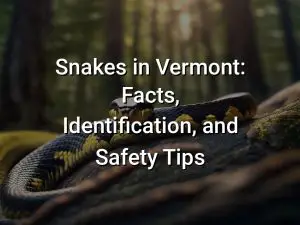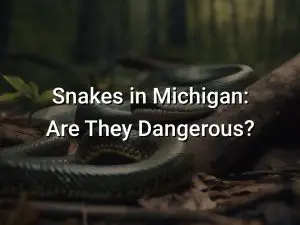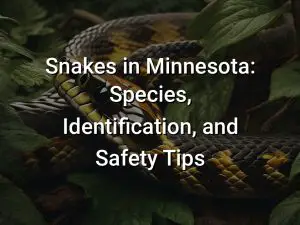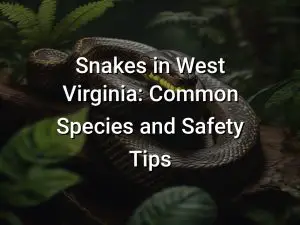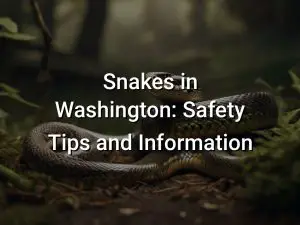Snakes in Oregon: A Guide to Identifying and Dealing with Snakes (Safety Tips)
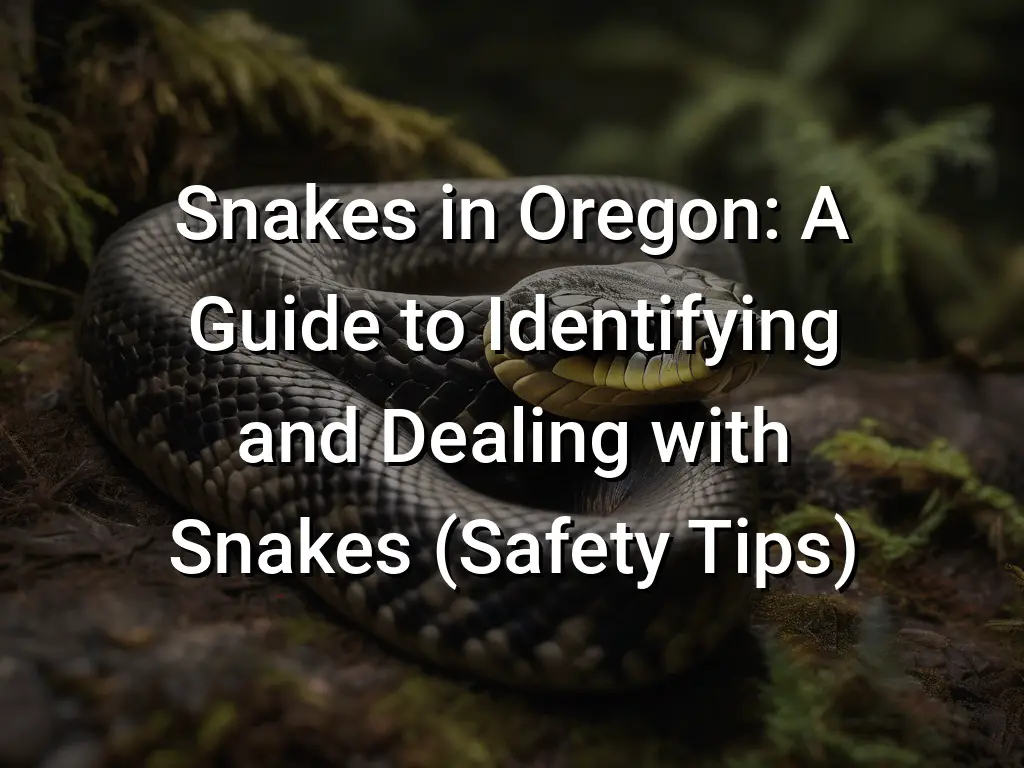
Are you curious about the snakes that inhabit Oregon? Whether you’re an avid hiker, a nature enthusiast, or just want to be prepared, this guide will help you better understand these slithering creatures and provide you with valuable safety tips. From the venomous Western Rattlesnake to the harmless Garter Snake, we’ll take a closer look at the common snakes found in Oregon and how to identify and deal with them.
While encountering a snake can be a thrilling experience for some, it’s crucial to know how to stay safe. In this article, we’ll also provide you with essential safety tips for dealing with snakes, including how to identify venomous snakes and what to do if you encounter one. Plus, we’ll share preventive measures you can take to minimize the chances of a snake encounter. So let’s dive into the world of snakes in Oregon and ensure you’re fully equipped to handle any snake-related situations!
Quick Links
Introduction
Welcome to our guide on identifying and dealing with snakes in Oregon. Snakes play an important role in our ecosystem, but encountering them can be a cause for concern. In this article, we will discuss the common snakes found in Oregon and provide safety tips for dealing with them. Whether you are a hiking enthusiast, a gardener, or simply want to be prepared, this guide will equip you with the knowledge and tools to coexist with snakes safely.
Common Snakes in Oregon
Oregon is home to a variety of snake species, some of which are harmless and others that can potentially pose a threat to humans. It’s important to be able to identify these snakes to ensure your safety and the well-being of the snakes. Here are some common snakes you may encounter in Oregon:
- Western Rattlesnake: The Western Rattlesnake is a venomous snake found in various habitats throughout Oregon. It can be identified by its rattling tail, triangular-shaped head, and distinctive diamond pattern on its back.
- Gopher Snake: The Gopher Snake is a non-venomous snake that is often mistaken for a rattlesnake due to its similar appearance and defensive behavior. It has a blotchy pattern on its back and can inflate its body to mimic a rattlesnake.
- Rubber Boa: The Rubber Boa is a non-venomous snake that is unique in appearance, with a blunt head, small eyes, and smooth, rubbery scales. It is known for its docile nature and ability to burrow in the ground.
- Garter Snake: Garter Snakes are common non-venomous snakes found throughout North America, including Oregon. They have long, slender bodies with stripes running along their sides and are often seen near water sources.
- Northwestern Ringneck Snake: The Northwestern Ringneck Snake is a small, non-venomous snake with a distinctive orange or red ring around its neck. It can be found in forests and woodland areas in Oregon.
- Sharp-Tailed Snake: The Sharp-Tailed Snake is a small, non-venomous snake with a pointed tail and smooth scales. It is usually brown or gray with a yellow or cream-colored belly and can be found in damp habitats.
Remember, most snakes in Oregon are harmless and play a vital role in the ecosystem by controlling rodent populations. If you encounter a snake, it’s best to observe it from a safe distance and allow it to go about its business. Avoid handling or disturbing snakes unless you have proper training and expertise.
Western Rattlesnake
The Western Rattlesnake is a venomous snake species commonly found in Oregon. It can be identified by its distinctive rattling tail, triangular-shaped head, and large, heat-sensing pits located between its eyes and nostrils.
Western Rattlesnakes are most active during the spring and summer months when they are often found basking in the sun or hunting for prey. They prefer dry, rocky areas such as desert grasslands, sagebrush, and rocky hillsides.
If you come across a Western Rattlesnake, it is important to exercise caution and keep a safe distance. Do not attempt to handle or provoke the snake, as it may bite in self-defense. Western Rattlesnake bites can be venomous and potentially life-threatening, so it is important to seek medical attention immediately if bitten.
To prevent encounters with Western Rattlesnakes, it is advised to watch your step and avoid walking in tall grass or brush where snakes may be hiding. When hiking or exploring areas known to have rattlesnakes, wear sturdy boots and long pants to protect yourself.
If you live in an area prone to Western Rattlesnake sightings, take precautions to snake-proof your property. This can include keeping your yard clean and free of clutter, sealing off potential entry points, and removing potential habitats such as woodpiles or rock piles.
Remember, Western Rattlesnakes play an important role in the ecosystem as predators of rodents. It is best to appreciate them from a safe distance and allow them to continue their natural behaviors in their habitat.
Gopher Snake
The Gopher Snake is a non-venomous snake commonly found in Oregon. It is often mistaken for a rattlesnake due to its similar appearance and defensive behavior, but it is harmless and plays a beneficial role in controlling rodent populations.
Gopher Snakes have a slender and elongated body with markings that resemble the patterns of some rattlesnake species, such as a diamond-shaped head and blotches along their back. However, their coloration can vary greatly, ranging from light tan to dark brown or gray. They are usually around 3 to 6 feet in length.
These snakes are excellent burrowers and are often found in sandy or rocky habitats, including deserts, grasslands, and open woodlands. They are active during the day and are known for their ability to climb trees and swim in water.
When threatened, Gopher Snakes will inflate their bodies and emit a hissing sound, imitating the behavior of rattlesnakes. However, they lack venom and rely on their intimidating appearance and defensive behavior to deter predators.
Gopher Snakes primarily feed on small mammals such as mice, voles, and gophers, hence their name. They are constrictors, meaning they squeeze their prey to subdue it before swallowing it whole.
If you encounter a Gopher Snake in the wild, it is best to observe it from a safe distance and avoid disturbing or provoking it. Remember that these snakes are harmless and play an important role in maintaining the ecosystem’s balance.
Always respect wildlife and their habitats, and if you have concerns about snakes in your home or property, contact a professional snake removal service to ensure a safe and humane resolution.
Rubber Boa
The Rubber Boa is a unique snake species found in Oregon. It is known for its rubbery and smooth appearance and is often mistaken for a worm due to its small size and blunt head. Here are some key characteristics and facts about the Rubber Boa:
- Size: The Rubber Boa is a relatively small snake, typically measuring between 14 and 30 inches in length. It has a stout body and a short tail.
- Coloration: The Rubber Boa has a wide range of color variations, including brown, tan, yellow, or olive. It may have dark blotches or stripes along its body.
- Habitat: Rubber Boas are found in a variety of habitats in Oregon, including forests, grasslands, and rocky areas. They prefer damp environments and are often found near streams or underground in burrows.
- Behavior: The Rubber Boa is a non-venomous snake and is known for its gentle and docile nature. It is primarily nocturnal, though it may be active during the day in cooler weather.
- Diet: Rubber Boas primarily feed on small mammals, including mice, shrews, and voles. They are constrictors and subdue their prey by squeezing until it suffocates.
- Reproduction: Mating typically occurs in the spring, and females give birth to live young in late summer or early fall. A female Rubber Boa can have up to 8 offspring per litter.
It’s important to note that the Rubber Boa is a protected species in Oregon and should not be handled or disturbed. If you come across a Rubber Boa, observe it from a distance and avoid causing it any harm.
Garter Snake
The garter snake is one of the most common snakes found in Oregon. It is a non-venomous snake that can be easily identified by its long, slender body and distinct coloration. Garter snakes usually have a base color of green or brown with yellow or white stripes running down the length of their bodies.
Garter snakes are typically found in a variety of habitats, including grasslands, forests, and wetlands. They are excellent swimmers and can often be seen near bodies of water, such as ponds or streams. Garter snakes are active during the day and are often seen basking in the sun to regulate their body temperature.
These snakes primarily feed on small vertebrates, such as frogs, fish, and rodents. They are known for their ability to catch and consume prey larger than their own head. Garter snakes are important predators in their ecosystems and help to control populations of rodents and amphibians.
When threatened, garter snakes may release a foul-smelling musk as a defense mechanism. They are generally docile snakes and will usually try to escape rather than confront humans. If encountered, it is best to observe the snake from a safe distance and avoid disturbing or handling it.
It is important to remember that all snakes play a vital role in maintaining the balance of ecosystems. They should be respected and protected, even if they may seem intimidating to some. If you find a garter snake in your yard or property, it is best to leave it alone and allow it to continue its natural behavior.
Northwestern Ringneck Snake
The Northwestern Ringneck Snake is a small, non-venomous snake that can be found in Oregon. It is known for its distinct ring patterns on its scales, which vary in color from yellow and orange to red and brown. The belly of the snake is usually a bright yellow or orange color.
These snakes are usually around 10-15 inches long and have a slender body. They are active mainly at night and prefer moist habitats such as forests, grasslands, and wetlands. They can often be found under rocks, logs, and other debris.
The Northwestern Ringneck Snake is harmless to humans and feeds primarily on small invertebrates such as insects, spiders, and earthworms. Despite their small size, they are known for their defensive behavior of curling their tail, exposing their bright belly, and emitting a musky odor when threatened.
If you encounter a Northwestern Ringneck Snake, it is best to simply observe from a distance and not disturb it. These snakes play an important role in controlling pest populations and are a valuable part of the ecosystem.
Sharp-Tailed Snake
The Sharp-Tailed Snake, also known as the Contia tenuis, is a small and harmless snake found in Oregon. It is a slender snake, with adults typically measuring between 10 to 17 inches in length. The Sharp-Tailed Snake has smooth scales and ranges in color from gray to reddish-brown with a lighter-colored belly.
This snake is primarily active during the night and prefers to inhabit moist, forested areas with dense vegetation. It is often found near streams, marshes, and other wet habitats. The Sharp-Tailed Snake feeds primarily on slugs, snails, and earthworms, using its sharp teeth to immobilize and consume its prey.
Despite its name, the Sharp-Tailed Snake is non-venomous and poses no threat to humans. It is generally shy and will retreat or hide when encountered by humans. In fact, it is sometimes mistaken for a worm due to its small size and slender body.
If you happen to come across a Sharp-Tailed Snake, it is best to observe it from a distance and avoid disturbing its habitat. Remember, this snake plays an important role in maintaining ecological balance by controlling populations of slugs and snails.
Safety Tips for Dealing with Snakes
When encountering snakes in Oregon, it’s important to prioritize your safety. Here are some tips to help you deal with snakes in a safe and responsible manner:
- Keep your distance: Snakes are generally non-aggressive and will try to avoid confrontation. If you come across a snake, give it plenty of space and do not attempt to handle or provoke it.
- Stay calm: It’s natural to feel fear or anxiety when encountering a snake, but it’s important to remain calm. Sudden movements or loud noises can startle the snake and may increase the chance of a defensive reaction.
- Do not attempt to kill or capture the snake: Killing or capturing snakes is not only unnecessary, but it can also be dangerous. Venomous snakes may bite in self-defense, and non-venomous snakes can still deliver a painful bite.
- Do not handle snakes unless you are trained: It takes skill and experience to safely handle snakes. If you are not trained in snake handling, it is best to leave them alone and call a professional snake removal service if necessary.
- Keep your property clean and clutter-free: Snakes are attracted to areas with ample hiding spots, such as piles of debris or overgrown vegetation. Regularly clean up your yard and remove any potential snake habitats.
- Wear appropriate footwear and clothing when outdoors: When hiking or exploring areas where snakes may be present, it’s important to wear sturdy closed-toe shoes and long pants. This can help reduce the risk of snake bites.
- Teach children about snake safety: Educate children about snakes and the importance of respecting wildlife. Teach them to stay away from snakes and what to do if they encounter one.
- Know the venomous snakes in your area: Familiarize yourself with the venomous snakes that are native to Oregon, such as the Western Rattlesnake. Knowing how to identify these snakes can help you take appropriate precautions and seek medical attention if necessary.
- If bitten, seek medical attention immediately: If you or someone you know is bitten by a snake, it is crucial to seek medical attention immediately. Do not attempt to treat the bite yourself.
By following these safety tips, you can minimize the risk of snake encounters and ensure your own well-being when dealing with snakes in Oregon.
Identifying Venomous Snakes
When it comes to snakes in Oregon, it’s important to be able to identify which ones are venomous and which ones are not. While most of the snake species in Oregon are harmless, there are two venomous snake species that you need to be aware of: the Western Rattlesnake and the Northern Pacific Rattlesnake.
The Western Rattlesnake is the most common venomous snake in Oregon. It has a thick body, triangular-shaped head, and a rattle at the end of its tail. The rattle is a warning sign, so if you hear it, you should stay away from the snake. This species can vary in color, ranging from light gray to dark brown, with blotches or bands along its body.
The Northern Pacific Rattlesnake is another venomous snake found in Oregon. It is similar in appearance to the Western Rattlesnake, with a thick body, triangular-shaped head, and a rattle at the end of its tail. This species can vary in color as well, usually ranging from grayish-brown to reddish-brown, with dark blotches along its body.
It’s important to remember that not all venomous snakes in Oregon have rattles. Some young rattlesnakes may have a button instead of a fully-formed rattle, and other venomous snakes, like the Copperhead, do not have rattles at all. Therefore, it’s crucial to look for other identifying features to determine if a snake is venomous.
When identifying venomous snakes, look for the following characteristics:
- Pit organ: Venomous snakes have a heat-sensing pit organ located between their eye and nostril. This helps them detect warm-blooded prey in the dark.
- Vertical pupils: Venomous snakes have vertical pupils, similar to a cat’s eye, whereas non-venomous snakes have round pupils.
- Head shape: Venomous snakes have a triangular-shaped head, while non-venomous snakes have a more rounded head.
- Scale pattern: Venomous snakes usually have a more irregular scale pattern, whereas non-venomous snakes have a more uniform scale pattern.
If you encounter a snake and are unsure if it is venomous, it’s best to err on the side of caution and give the snake a wide berth. Do not attempt to handle or approach the snake, and remember that snakes are generally more afraid of you than you are of them. If you need help identifying a snake or have concerns about a snake on your property, it’s advisable to contact a local wildlife or pest control professional for assistance.
What to do if you Encounter a Snake
Encountering a snake can be a surprising and potentially alarming experience, but it’s important to remain calm and take appropriate action. Here are some steps to follow if you come across a snake:
- Stay calm and still: Snakes are typically more afraid of humans than we are of them. Avoid sudden movements or loud noises that may startle the snake.
- Step back: Slowly and carefully back away from the snake to give it space. Do not try to touch or handle the snake.
- Observe from a safe distance: If the snake is not aggressive and is not causing immediate danger, it’s best to observe it from a safe distance. This will allow you to identify the snake and assess the situation.
- Identify the snake: Use caution and try to identify the snake from a safe distance. Refer to our guide on common snakes in Oregon to help with identification.
- Call for professional help: If you are unsure about the species of snake or if it poses a threat to you or others, contact local wildlife authorities or a professional snake removal service for assistance.
- Do not attempt to handle or kill the snake: It is not recommended to handle or kill a snake, as this can be dangerous and may also have legal consequences. Let the professionals handle snake removal if necessary.
- Keep children and pets away: If you encounter a snake in a residential area or near a playground, make sure to keep children and pets away from the snake until it can be safely removed.
- Modify your surroundings: If you frequently encounter snakes on your property, consider making modifications to discourage them from entering, such as removing debris, sealing holes and gaps in buildings, and keeping grass and shrubs trimmed.
Remember, most snakes are not harmful and play an important role in the ecosystem. It’s best to observe them from a safe distance and allow them to retreat to their natural habitat.
Preventing Snake Encounters
While encountering snakes in Oregon is relatively rare, there are steps you can take to minimize the chances of an encounter and ensure your safety:
- Keep your yard tidy and free of debris: Snakes are attracted to areas with tall grass, piles of leaves, and clutter. Regularly mow your lawn, trim shrubs, and remove any potential hiding spots for snakes.
- Seal off potential entry points: Snakes can enter your home through small cracks and openings. Inspect your house and seal off any gaps around doors, windows, pipes, and vents.
- Store firewood properly: If you have firewood, keep it at least 20 feet away from your home and elevated off the ground. This helps prevent snakes from using the woodpile as a hiding spot.
- Clear out rodent infestations: Snakes are attracted to areas with abundant food sources, such as rodents. Take steps to prevent or address any rodent infestations in and around your property.
- Wear appropriate footwear: When venturing into areas where snakes may be present, such as hiking trails or wooded areas, wear closed-toe shoes or boots to protect your feet.
- Be mindful of your surroundings: While enjoying outdoor activities, stay alert and watch for any signs of snakes, such as rustling leaves or sunbathing on rocks. Avoid tall grasses and brush whenever possible.
- Keep pets on a leash: If you’re walking your dog in snake-prone areas, keep them on a leash and avoid letting them explore under rocks, logs, or bushes. Dogs are more likely to encounter snakes and can be at risk of bites.
- Don’t disturb snake habitats: Snakes play an important role in the ecosystem, so it’s best to leave them alone and avoid disturbing their habitats. Enjoy wildlife from a safe distance.
- Learn to identify snakes: Educate yourself about the different snake species in Oregon and learn to distinguish venomous snakes from non-venomous ones. This knowledge can help you make informed decisions if you encounter a snake.
By following these prevention tips, you can reduce the likelihood of encountering snakes and ensure your safety in snake-prone areas.
Conclusion
Encountering snakes can be a common occurrence in Oregon, but with the right knowledge and precautions, you can ensure your safety and the safety of the snakes. By familiarizing yourself with the common snake species in the area and learning to identify venomous snakes, you can confidently navigate outdoor spaces without fear.
If you do come across a snake, it’s important to stay calm and give the snake its space. Most snakes are not aggressive and will only attack if they feel threatened. By following the safety tips outlined in this guide, you can minimize the risk of snake bites and peacefully coexist with these fascinating creatures.
Remember, snakes play an important role in the ecosystem and should be respected as valuable members of the natural world. By taking the necessary precautions and treating snakes with caution and respect, you can enjoy the beauty of Oregon’s wilderness while staying safe.

